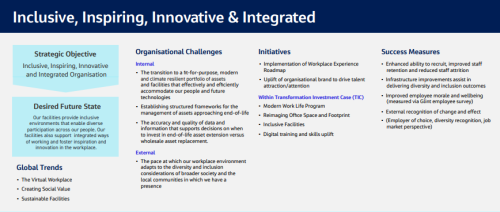Airservices Australia (Airservices) delivers, owns, and manages a unique set of services, assets and features that are core enablers to the aviation and aerospace sector in Australia. To provide stability during future periods of change, Airservices recognised the need for a performance and decision-making framework focused on their facility assets. This framework would provide the capability to manage assets sustainably, ensuring the asset portfolios comprising Airservices three service lines; Aerospace Services, Aviation Rescue Fire Fighting Services, and Enabling Services, and the asset classes relevant to each are supported by robust infrastructure that will continue to deliver under evolving operating conditions.
Airservices and Jacobs partnered to establish the foundation for a program of asset and facility
management capability uplift, collaboratively working to develop and implement an asset
management and facilities management improvement roadmap. The roadmap included a
‘runway’ of initiatives to align and optimise facilities management across the organisation. The Facilities Strategy Plan (FSP) was identified to provide the overarching framework and direction to prioritise key initiatives that deliver benefit to Airservices customers, people and owners.
The FSP assessed the current state performance of Airservices facilities through six lenses: People, Location, Capability, Inter-dependency, Digital Cohesion, and Sustainability. The lenses identified the global macrotrends and industry drivers that
influence and impact their asset portfolios, and the opportunities and step changes required to ensure the future resilience of the people, assets and technology that deliver Airservices’ core functions. Challenges that may impact the achievement of the strategic objective were drawn from external and internal sources viewed through the current state lenses. Each strategic objective has a set of associated initiatives that mitigate the challenges
and are measurable by their success in delivering Airservices outcomes for people, customers and owners in the near to medium term. The project is a mature recognition of the need
to set strategic objectives and guidance before continuing with reactive lifecycle activities.
Use of best practice asset management
principles
The 2022 AMPEAK conference closed with a presentation on the global megatrends affecting
asset management, which Airservices and Jacobs attended together. This discussion proved the
catalyst for conversations leading to this project’s inception.
The purpose of the conference was to engage industry on best practice and emerging trends in
asset management, and the origin of this project reflects its alignment with industry best practice. The project demonstrates a significant transition in Airservices’ approach to facilities management from a preventative and reactive practice to strategic asset lifecycle planning, and deliberately responding to the macrotrends seen across the aviation industry. The project has reoriented the business towards a forward-looking model of predictive and sustainable facilities management that supports resilient, future-proof operations. Some examples of the trends and challenges included in the FSP are provided in the following sections addressing originality and benefits, and are captured in the workshop mural board graphic provided below.
Airservices sought a plan tailored to the unique set of services they provide across the Australian
aviation sector that would present tangible outcomes, easily relatable to departments, teams
and individuals across the organisation. The success of the final FSP in achieving this
reflects best practice in producing asset guidance that is accessible and has a genuine impact on corporate level decision-making. Degree of originality and ingenuity of solution In the operationally driven, time-pressured environment of critical facilities, it is noteworthy
to find an organisation investing in reimagining their approach to asset management to embed
resilience and sustainability in their assets and operations.
Program and project management
From a project management perspective, the
project had a planned schedule and deliverables
with phase progression as follows:


- Current state assessment,
- Future state objectives,
- Gap analysis, and
- Action plan and implementation schedule.
Jacobs facilitated a series of workshops and codevelopment sessions to engage the right people in the process. Weekly progress meetings monitored activities against schedule and presentations were made to the executives at project completion. The project was completed on-time and to the approved budget. Benefit/Value of the project or service
to the community or organisation The project produced outcomes that have tangible
impact on the Airservices organisation, and its’ workforce and stakeholders who benefit from the services it provides. Airservices has benefited from the development and implementation of these facility management activities, and are well prepared to progress along their overall asset management roadmap. The FSP, a key element of the roadmap, has
provided Airservices with strategic direction for continuous improvement of facilities management.
Six strategic objectives were defined and serve as guiding principles for the future-focused
implementation of the FSP decision-making framework. A number of these will have significant and direct benefits to the organisation and local communities, including:
Inclusive, inspiring and integrated workspaces
‐ Upgrading sites to foster modern, safe and
inclusive workplaces that represent the
communities, and ensuring people have the
right access to support their work,
‐ Regional talent sourcing and employment
opportunities across facilities in regional
centres,
‐ Virtual workspaces enabling flexibility in ways
of working,
‐ Health and wellbeing, and
‐ Investment in learning and development for
workforce.
Sustainable, efficient and scalable operations
‐ Environmental efficiencies in operation of
buildings, spaces and rooms, and
‐ Supply chain – economic growth and job
creation.
Adaptive and resilient infrastructure
‐ Leveraging partnerships in industry –
opportunities for local businesses, and
‐ Creating social value – spaces that encourage
and foster recreation and connection across the
property portfolio

